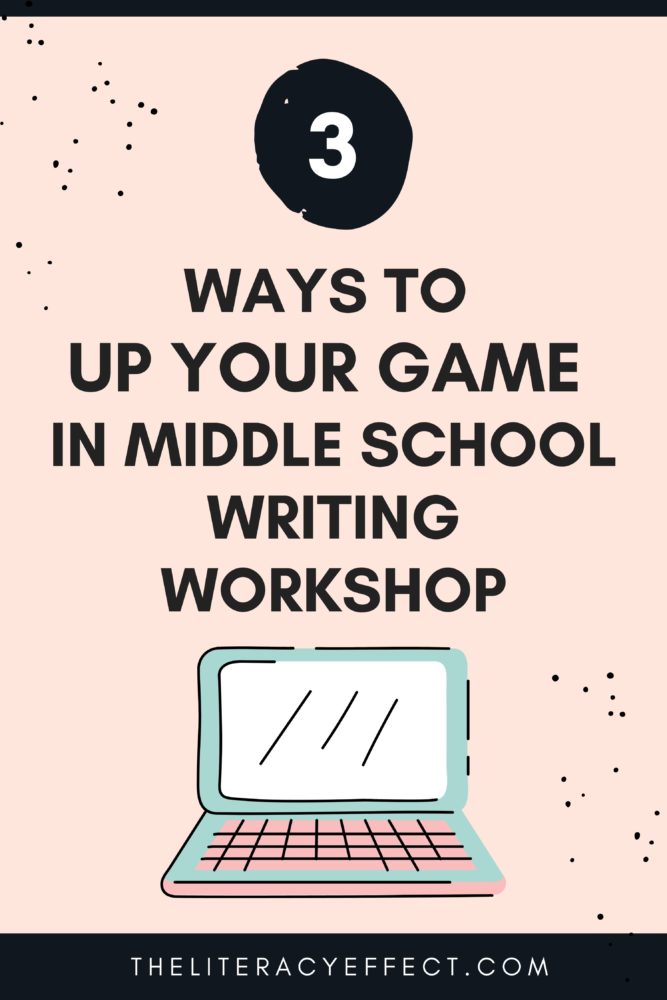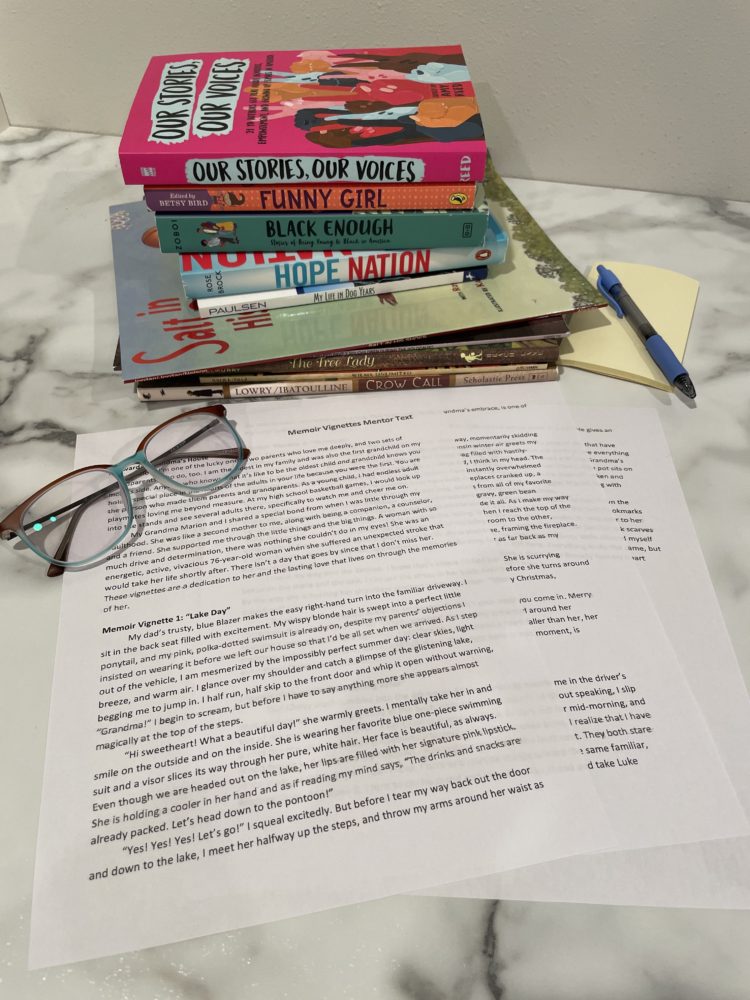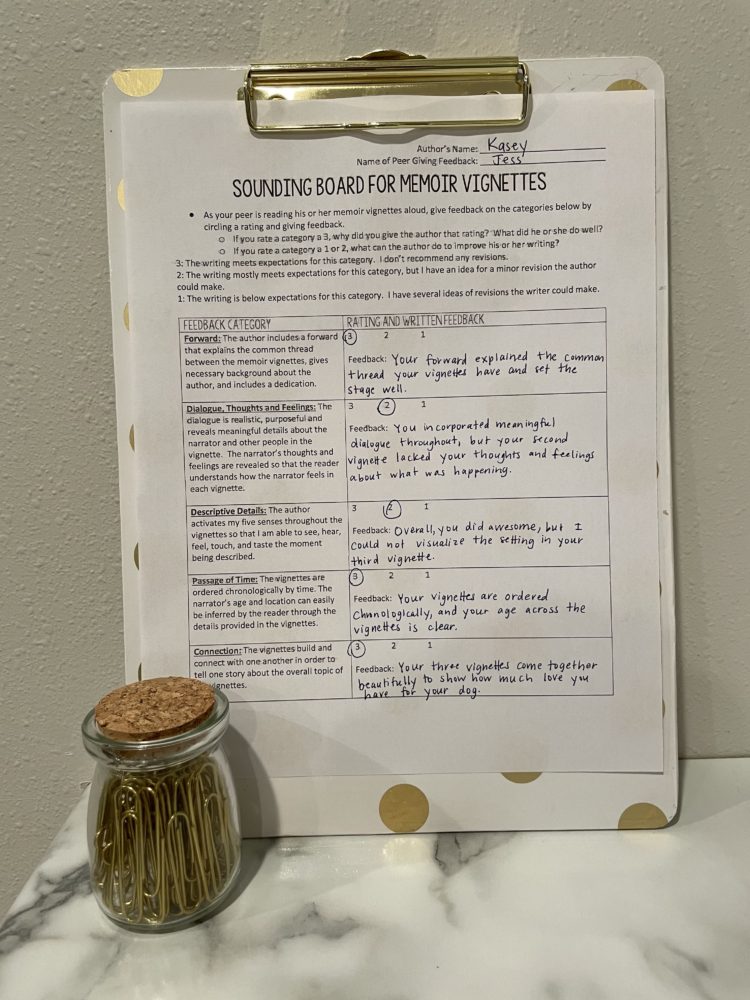I’ve blogged a lot over the years about Writing Workshop in middle school. Teaching writing to middle school students is no easy feat, so I wanted to treat you to some new thoughts about Writing Workshop for middle school students and give you a few fun free links so that you’re able to put the ideas from the post into immediate action.

Idea One: Use Mentor Texts Strategically
During a writing unit, the mentor text you use should represent the final product that you want students to strive for. If you’re doing a persuasive letter writing unit, your mentor text shouldn’t be some random persuasive letter that you pulled off the Internet that has only some elements you want students to have in their persuasive letter. It’s pretty much impossible to Google the perfect mentor text for a specific writing unit because it’s not YOUR writing unit for YOUR students. My opinion is the best possible mentor text comes from the teacher. If you take the time before a writing unit begins or even go through the writing process alongside students to compose a writing piece of your own, this is the most authentic mentor text you can have.
An even greater added benefit of writing your own mentor text is it gives you an opportunity to model being a reflective writer to your students. Showing students that you’re willing to revise and edit a mentor text you created will transfer into their willingness to revise and edit. Another great option is to keep exemplar student writing over the years for specific writing units that can also be used as mentor texts and pull passages from mentor texts within the genre students are writing to have on hand. For example, when students are doing my Memoir Vignettes Writing Unit, I would pull memoir books and select passages of realistic dialogue or beautiful sensory language to share with students strategically throughout the unit.
Whenever I start a new writing unit with students, the very first day of the writing unit always starts by asking students to critically read the mentor text for the genre of writing we will be diving into. I often have students do this in partners and highlight the mentor text and write down what they notice about it. Looking at the mentor text on the first day of the writing unit gives students a vision of what they will be striving for over the next few weeks. After the initial day of looking at the mentor text as a whole, the mentor text is then used in smaller bites as we complete minilessons across a writing unit. If we are doing a writing minilesson on including specific examples and evidence to support reasons in a persuasive letter, we would go back to the mentor text to study how I did these things as an author. I love that students look at the same mentor text over and over that they are familiar with so that they can truly look at one small piece of the mentor text during a specific writing minilesson. If I used a different mentor text each time, I would have to take the time to read the mentor text with students and familiarize them with it. This is time we don’t have in middle school ELA classrooms for every minilesson.
A strong mentor text is also a great guided writing or writing conference tool. When conferencing with students, I find it helpful to have a familiar mentor text that we’ve been referencing throughout the unit to show examples from. Providing every student a physical copy of the mentor text to keep also gives them the opportunity to go back and study what they talked to the teacher about post-conference or guided writing group. This is also a great place to use past students’ exemplar writing and published works within the genre students are writing in.
If you teach a persuasive letter writing unit, feel free to grab a mentor text that I wrote and use it in your unit by clicking here. This is a Google Drive force link copy, so it will prompt you to save a copy of the Google Doc in your Google Drive. From there, you are free to edit and use it in your classroom with your students. Also, if you’re thinking that you love the idea of having mentor texts specific to a writing unit but know that taking the time to write them is not feasible, I want to let you know that all 10 writing units in my Year-Long Writing Curriculum resource contain at least one mentor text written by me specifically for the purpose of that writing unit.

Idea Two: Use a Peer Sounding Board for Revision
Most writing units that I do with my students last between 13-16 class days and are composed of 13-16 writing minilessons (one writing minilesson per day). After students get exposed to the genre, pre-write, outline, and draft their writing, revision comes next. I generally do 3-4 days of revision with the last revision day being a peer sounding board. The revision days leading up to the peer sounding board are focused revision where students examine their writing for one specific thing and make their own revisions. I have completely ditched the type of peer revision and editing that involves one student handing their writing to another student and having that student fix it for them. To me, this practice is not beneficial to the writer or the peer doing the revising or editing. A student’s writing should be a reflection of who they are as a writer at the point they are in their current writing development. The purpose of Writing Workshop is not for every student to have a flawless piece at the end. How am I supposed to get to know my students as writers if their writing is taken over by someone else?
So what do I do instead? I have switched over to using a peer sounding board. What this process looks like is students get in groups of 3-4 and circle up. One student at a time reads their writing aloud while the other students listen and give feedback on a peer sounding board sheet. I have done sounding board revision with my distance learning students as well using the same format in Google Classroom Breakout Groups. The peer sounding board sheet lists 4 specific pieces of criteria students are centering their feedback around that are also pieces of the final writing rubric. Students give each other a rating and written feedback on each category on the sounding board. Once a student is done sharing, students go around the circle and share one thing they think the student did well as a writer and one thing that could be improved. All students then give the sounding board sheet to that student so they have written feedback about where to go back and make revisions.
This is a great way for students to collaborate as writers and create a community of writers without using peer revision and editing with the traditional exchange and fixing of others’ writing. Instead, they have to listen to other students’ ideas and give actual revisions. Because let’s face it. Peer revision always ends up being peer editing as students seem to be more comfortable fixing other students conventions than they are giving them feedback on how to revise the content of their writing. I also love that students read their entire writing piece aloud in a small group setting. Often times, students find several things they want to change just from reading the entire piece out loud to their sounding board group.

If you’re interested in trying out a peer sounding board with your students as you near the end of the revision process, feel free to grab this free Sounding Board Template. It will bring up a force link to a Google Doc. This will allow you to save the file in your Google Drive and adjust it to fit your needs. Each of my 10 writing units includes a sounding board activity with specific criteria listed that aligns to the final rubric students are graded on for that writing unit.
Idea Three: Strategically Plan Student Feedback
First of all, I want to define, or possibly redefine, student feedback. To me, the traditional student feedback we think of is feedback teachers give students orally or written. However, it can also be feedback peers give each other or feedback students give themselves through self-reflection.
I used to collect all students’ writing at the end of a writing unit and spend a ridiculous amount of time writing meticulous feedback on every students’ writing piece. It actually pains me a little to think about all of the time I wasted doing this. I call this time a waste because what good comes from giving students a majority of your feedback after their final piece is done? Teacher feedback should be heavily focused during the revision process of the writing cycle. During the 3-4 days of revision during a writing unit, I try to read and give oral or written feedback to all of my students. There are so many benefits that I’ve found to doing it this way. The first being that I’m giving students feedback at a point in the writing process where they are actually still willing to change their writing. Also, it makes grading SO much easier because I’ve already read and given feedback on all of my students’ writing and can simply use the detailed rubric I’ve created to give summative feedback on their final piece.
In the daily Writing Workshop format that I use with students, the last piece of the Writing Workshop framework is the “Share” portion of the lesson. This is a great way to incorporate peer feedback and self feedback daily. Taking the last 2-3 minutes of a class period to have students share what they did as writers that day with another student or a small group of students and get quick feedback is effortless and effective. I also love posing a self-check question some days during the share portion to give students a chance to focus in on the daily writing minilesson and check-in on themselves and how they did as a writer that day.
Each writing minilesson within my writing curriculum for middle school students includes writing conference questions to ask that are tailored to the specific minilessson for that day and a share prompt at the end of the writing minilesson to pause for feedback and reflection. The share prompt can be used as a way for students to check-in with themselves, a partner, or even a small group.
Final Thoughts
I’m hoping there was something here for you in this blog post that will help you up your game as you continue to use Writing Workshop to teach writing to your middle school students. Please let me know questions you have about using Writing Workshop in middle school or share other items that have helped you use Writing Workshop with your students. I look forward to hearing from you!
Kasey





